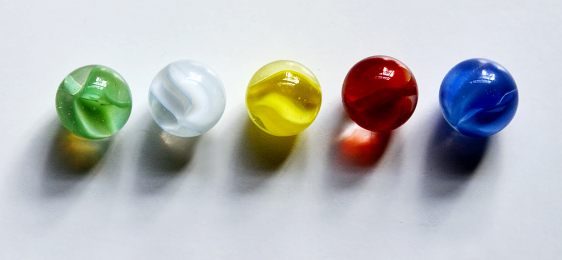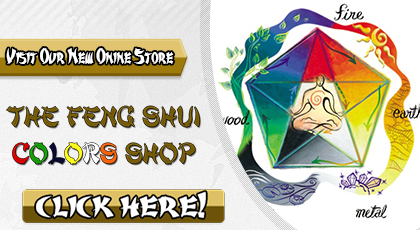

The concept of color in Feng Shui.
To obtain a deep understanding of Feng Shui, it is very important to understand the relationship between colours and elements. In Feng Shui, there are five basic colours, which are assigned to the following elements:
 Red represents the element of fire and in China, it is traditionally the colour of happiness, fame and power. Following the tenets of Feng Shui, red is the colour that most likely attracts happiness. Fire is a very strong element, which exerts its power especially during the dark winter months. Due to the enormous strength of this element, the colour red should be used sparingly in rooms. The teachings of Feng Shui tell us that too much red can exert excessive dominance over other energy flows. Reddish tones or hues are best suited for kitchens or south facing rooms..
Red represents the element of fire and in China, it is traditionally the colour of happiness, fame and power. Following the tenets of Feng Shui, red is the colour that most likely attracts happiness. Fire is a very strong element, which exerts its power especially during the dark winter months. Due to the enormous strength of this element, the colour red should be used sparingly in rooms. The teachings of Feng Shui tell us that too much red can exert excessive dominance over other energy flows. Reddish tones or hues are best suited for kitchens or south facing rooms..
 Green represents the element wood. The element wood represents prudence, hope and strength. Green is also considered to improve healing and radiates peace. Additionally, green is used to promote serenity. However, if green is used in conjunction with red, it is possible that the positive properties associated with green will become negative. This colour combination promotes instability and jealousy. You should not use too much green at once, because this can also have a negative impact. Too much green will change the energy flow from promoting calmness and serenity to inertia and stagnation. Greens should be used in the dining room, bedrooms, children’s rooms or rooms facing east.
Green represents the element wood. The element wood represents prudence, hope and strength. Green is also considered to improve healing and radiates peace. Additionally, green is used to promote serenity. However, if green is used in conjunction with red, it is possible that the positive properties associated with green will become negative. This colour combination promotes instability and jealousy. You should not use too much green at once, because this can also have a negative impact. Too much green will change the energy flow from promoting calmness and serenity to inertia and stagnation. Greens should be used in the dining room, bedrooms, children’s rooms or rooms facing east.
.
 The colour Yellow represents the element earth. Yellow is a very multi-faceted colour. In Feng Shui, the colour yellow represents brightness and longevity and in a wider sense even wisdom, patience, forbearance and tolerance. In Ancient China, yellow was such a special colour that only the emperor was allowed to use it. It was prohibited for normal people to wear clothes with the colour yellow or using the colour otherwise. Yellow curtains, towels and furniture were also reserved for the emperor. Even today in Feng Shui, yellow is considered to be the colour of money and is especially lucky. This colour is also said to represent force, stimulate the mind and have an inspiring effect on people. Therefore, this colour is very suitable for the office, living room and rooms facing west.
The colour Yellow represents the element earth. Yellow is a very multi-faceted colour. In Feng Shui, the colour yellow represents brightness and longevity and in a wider sense even wisdom, patience, forbearance and tolerance. In Ancient China, yellow was such a special colour that only the emperor was allowed to use it. It was prohibited for normal people to wear clothes with the colour yellow or using the colour otherwise. Yellow curtains, towels and furniture were also reserved for the emperor. Even today in Feng Shui, yellow is considered to be the colour of money and is especially lucky. This colour is also said to represent force, stimulate the mind and have an inspiring effect on people. Therefore, this colour is very suitable for the office, living room and rooms facing west.
.
 White represents the element metal. Although many of us consider white to be a positive colour, this is very different in traditional China. Although the colour white represents purity, it also represents sadness. Precisely for this reason, one should strictly avoid using white in living areas. However, white can be used in garages and workshops.
White represents the element metal. Although many of us consider white to be a positive colour, this is very different in traditional China. Although the colour white represents purity, it also represents sadness. Precisely for this reason, one should strictly avoid using white in living areas. However, white can be used in garages and workshops.
.
 Perhaps unusual, but the colour Black represents the element water. The element water represents money, power and influence. However, it also stands for lack of hope, misfortune, night and destruction. Black is also responsible for the disappearance of light. Nevertheless, in Feng Shui, black is not considered a colour of mourning, which is associated with white. Just like the colour white, black should also be avoided or at least mitigated by combinations with other colours. If you want to use black, it should be used in the bathroom, toilet, store room or the laundry room, but consider extenuating it with other colours.
Perhaps unusual, but the colour Black represents the element water. The element water represents money, power and influence. However, it also stands for lack of hope, misfortune, night and destruction. Black is also responsible for the disappearance of light. Nevertheless, in Feng Shui, black is not considered a colour of mourning, which is associated with white. Just like the colour white, black should also be avoided or at least mitigated by combinations with other colours. If you want to use black, it should be used in the bathroom, toilet, store room or the laundry room, but consider extenuating it with other colours.
.
.
These colours are the five basic colours in Feng Shui. Before I end this article, another important thing to consider is harmony. If you want to set up your living space [reduceazon-image align=”right” asin=”1568360142″ locale=”us” height=”110″ src=”http://ecx.images-amazon.com/images/I/51AKAnVPrlL._SL110_.jpg” width=”97″]harmoniously, then you must match the arrangement of the elements and colours. In the tenets of Feng Shui, it is believed that both productive and destructive interactions of the elements are present. Of course we are pursuing the productive elements. Furthermore, there is productive and destructive interaction in a creation and destruction cycle. The knowledge of these cycles will allow you to optimally match the colours of your living space. This will be the subject of the next article.
Featured Image (c) Andrew Morrell www.flickr.com










Comments
The effects can be very substantial, and far too often explains why people are unhappy and lethargic. Along with feng shui and other environmental metaphysics, color psychology is a very simple yet powerful tool for creating your own reality.